Newer, faster PCIe 5.0 SSDs coming soon — Phison reveals E26 Max14um and E31T controllers
Phison also showed off USB 4 external drives and discussed its upcoming E27T PCIe 4.0 controller.
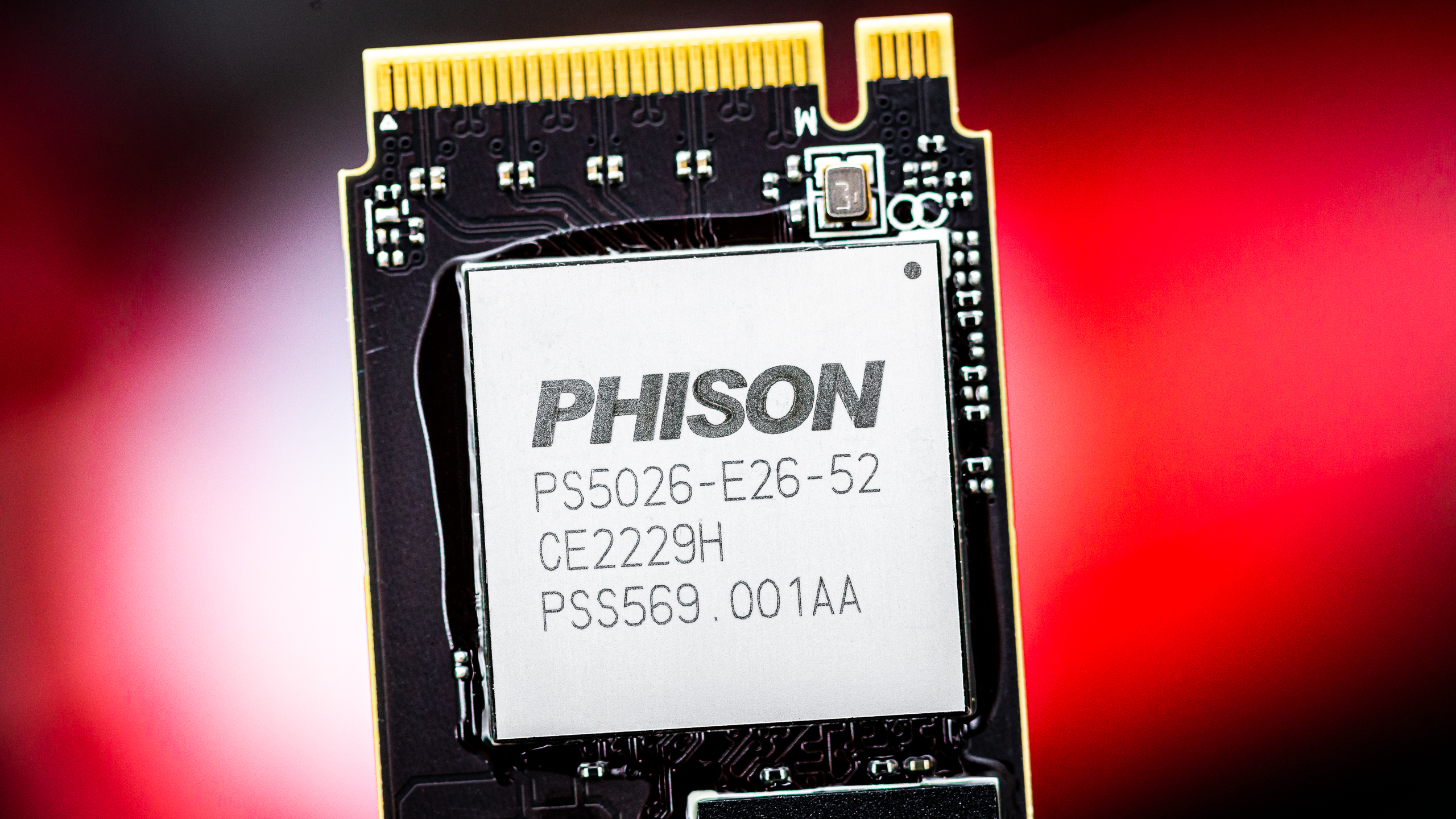
Last month, Phison started talking about its upcoming E26 Max14um controller and some mainstream parts. We saw quite a few drives powered by Max14um at CES, and we also stopped by the Phison booth to go hands-on with some of the drives and discuss some of the finer details. These new drives will power some of the best SSDs in the coming year, though some are still under embargo for now.
Phison showed off four new and upcoming controllers at its CES 2024 suite: The E26 Max14um, the E31T mainstream PCIe 5.0 controller, the E27T PCIe 4.0 controller, and the U21 USB 4 controller. Let's take a closer look at each.
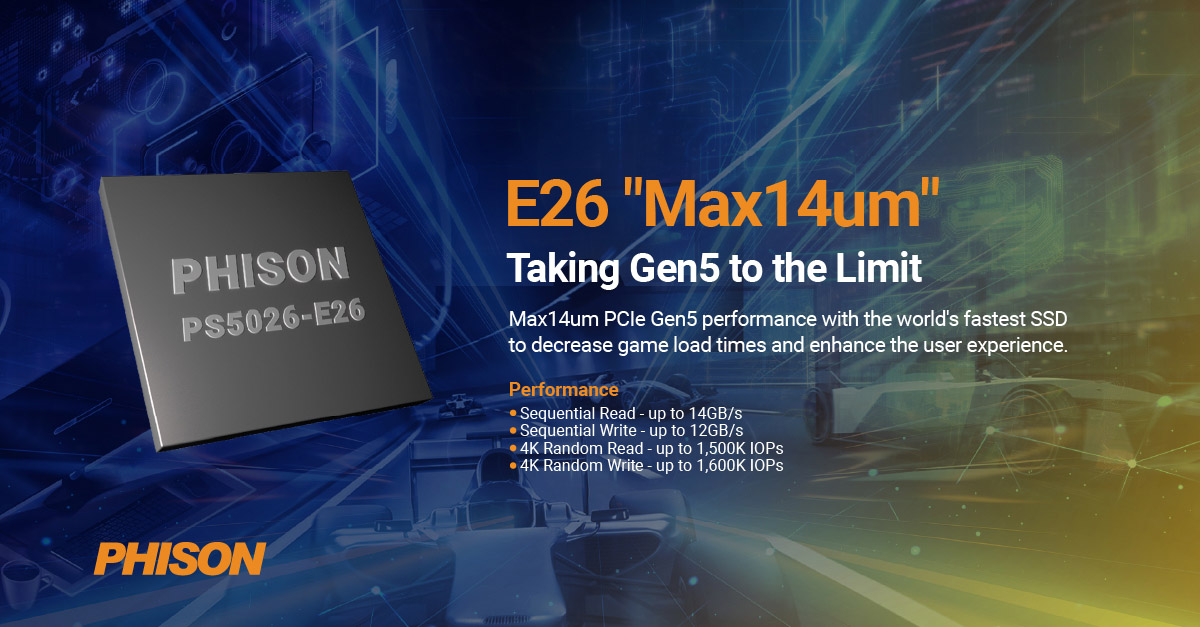
The Phison E26 controller hardly needs an introduction, as it's the only currently shipping consumer solution for PCIe 5.0 M.2 SSDs. It's behind the Crucial T700 (and T700 4TB), Corsair MP700, Adata Legend 970, Inland TD510, Gigabyte Gen5 10000 and Gen5 12000, Nextorage NN5Pro and NE5N, and Seagate FireCuda 540. The E26 Max14um has been tuned to reduce power use slightly, which allows it to hit even higher speeds of over 14 GB/s reads when paired with Micron's 2400 MT/s 232-layer TLC NAND.
Even more, companies appear ready to release new drives based on the updated E26 Max14um, and with the firmware tweaks, that should also mean any of the earlier teething pains are now in the past. Active cooling is still a requirement, and the drives aren't a good fit for laptops, given they have idle power use of around 2.5~2.9 watts. But if you want the fastest consumer SSD around, you should have plenty of drive models to choose from in the coming months. They'll all have the same core hardware, naturally, with only minor differences in cooling and other features.
Key specs for the E26 Max14um include up to eight channels with 32-chip enable, a dual CPU architecture with two ARM Cortex-R5 processors, and support for TLC and QLC NAND with speeds of up to 2400 MT/s. Both DDR4 and LPDDR4 memory are supported, along with AES256, SHA512, RSA-4096, and TCG OPAL hardware encryption. Current read speeds top out at over 14,000 MB/s, writes of 12,000 MB/s, up to 1,500K 4K random read IOPS, and up to 2,000 4K random write IOPS.
Phison could theoretically go even faster with the E26 controller, but it appears to be hitting the power limits of the M.2 slot, which is why 14,000 MB/s writes aren't quite possible. (Yet?) We have a reference drive for testing and will post a preview of the Max14um with full test results shortly.
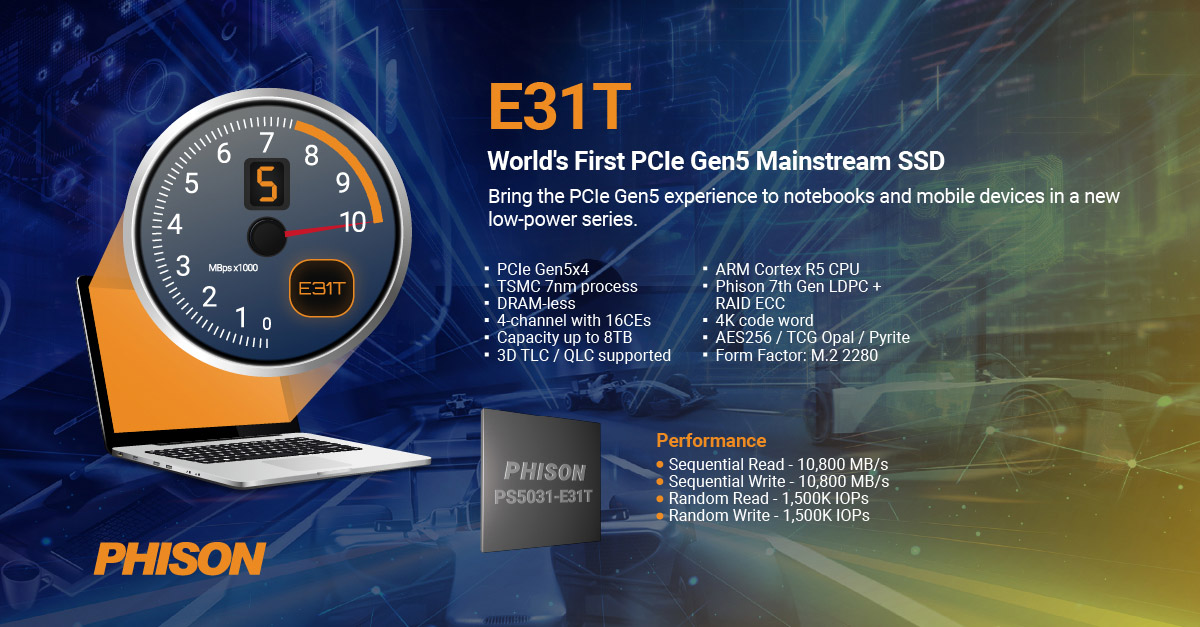
The Phison E31T controller ends up as both the more advanced and less advanced sibling of the E26. It's more advanced because it's manufactured on TSMC's 7nm N7 process node, where the E26 uses the 12nm node. That should greatly reduce power consumption, and Phison has also focused on other ways to cut down power use.
The E31T has a single Cortex-R5 controller, with up to a 4-channel configuration and 16 chip enable. That makes it half of an E26 in some respects, and it's also a DRAM-less design. However, we're not too worried about that, as the Maxio MAP1602 has proven to be quite capable even without DRAM (check the Lexar NM790 and Addlink A93 reviews as an example).
The E31T will also support up to 3,600 MT/s NAND (TLC or QLC). That will provide maximum read/write speeds of 10,800 MB/s and up to 1,500K 4K random read/write IOPS. So, in some cases, it's just as fast as the E26 controller; in others, it's slightly slower, but it should be a much better potential fit for upcoming laptops that feature PCIe 5.0 storage support.
The E31T will also be supported in non-heatsink designs, which is basically required to go into laptops. Single-sided 2TB SSDs using the E31T should also be available in the coming months.
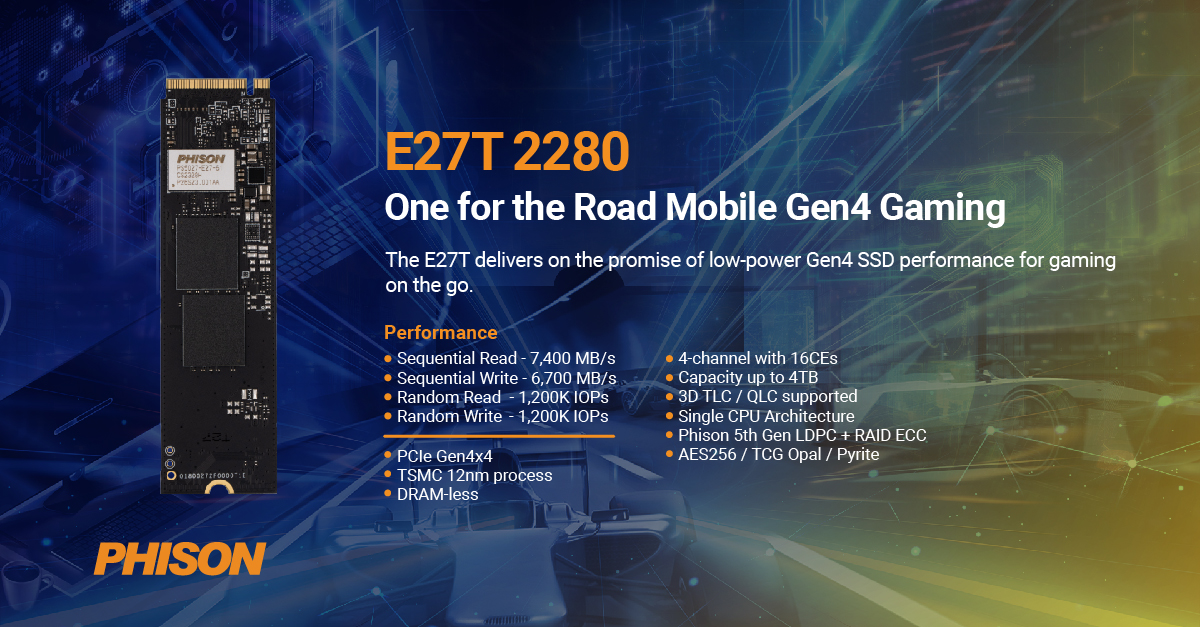
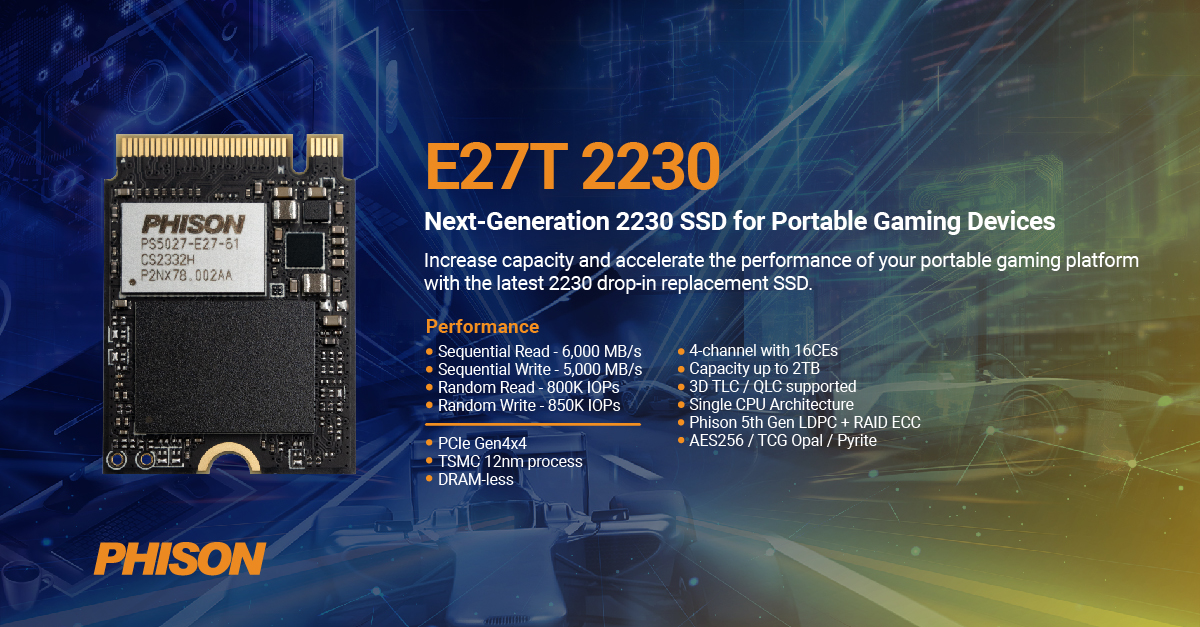
The last M.2 controller is the updated E27T, and here, Phison has showcased both the 2280 and 2230 form factor potential. The controller is the same in either case, a PCIe 4.0 4-channel, 16 chip enable DRAM-less design. However, the 2230 has reduced power use and thus cuts the performance a bit.
In 2280 form factor with TLC NAND, Phison specifies performance of up to 7,400/6,700 MB/s read/write, and 1,200K IOPS for 4K random read/write. That's nearly as fast as you can get with PCIe 4.0 and should be great for laptops and mainstream desktops. Performance drops to 6,000/5,000 MB/s read/write in the 2230 form factor and 800K/850K read/write 4K random IOPS.
Both variants will support TLC and QLC NAND of up to 3,600 MT/s, with maximum performance coming from TLC variants. We expect to see some 2TB TLC 2230 models in the coming year that should give a nice bump in performance for the latest gaming handhelds, with better sustained write speeds — not that it will make much of a difference on the best Steam Deck SSDs, as they're limited to PCIe 3.0 speeds, but other handhelds with PCIe 4.0 support should benefit.

Finally, Phison showed off a new USB 4 controller dubbed the U21 (PS2251-21). Phison claims this is the world's first USB 4 single-chip solution for portable devices and unconventional form factors. The controller is capable of speeds of up to 4GB/s and of course also provides for backward compatibility with USB 3.2.
We've also included a few photos from the Phison suite at CES 2024 in the above gallery, showing some of the prototype testing hardware for upcoming SSDs. Phison PCIe 5.0 redriver and retimer chips are also showing up on quite a few motherboards to help with signal integrity — any PCIe 5.0 slots that aren't right next to the CPU socket will generally need at least one redriver or retimer in order to function properly.
Get Tom's Hardware's best news and in-depth reviews, straight to your inbox.

Jarred Walton is a senior editor at Tom's Hardware focusing on everything GPU. He has been working as a tech journalist since 2004, writing for AnandTech, Maximum PC, and PC Gamer. From the first S3 Virge '3D decelerators' to today's GPUs, Jarred keeps up with all the latest graphics trends and is the one to ask about game performance.
-
Oldcompsci I'd really love to see MB manufacturers install more x4, x8 and x16 PCI-E expansion slots that can be used to host these NVME drives in vertically. The current trend to try cram more NVME drives in the limited horizontal space available on the motherboard is a waste. Also, most users don't need more than two "superspeed" usb ports for the front, two for the back and a pair of USB 2.0 ports for a keyboard and mouse on the back. If they need more USB connectivity the can use USB hubs. Put the rest of the PCI-E lanes to better use with the expansion slots.Reply -
Geef ReplyOldcompsci said:Also, most users don't need more than two "superspeed" usb ports for the front, two for the back and a pair of USB 2.0 ports for a keyboard and mouse on the back.
Oh, but I want to plug my mouse into the USB slot with the pretty color! Not that dark one. 😜 -
Gu3sts What does this do for drive endurance as they get faster & faster, how much real world noticeable difference is there outside of benchmarks ??Reply -
George³ There seems to be some increase in random reading speed of small files. Something like 5-10%? I could be wrong.Reply -
Tom Sunday Reply
Max power output? I am m still trying to getting my eyes from trying to read and digest "Max14um". Actually Phison already demonstrated the PS5026-E26 Max14um at the Flash Memory Summit in 2023 and which has in many ways since dominated the ranks of PCIe 5.0 SSDs…but stands again completely irrelevant for all consumers. Further I can't understand all the hype about 10GB/s and more. No normal user needs it. They should instead build the controllers so that more than 4TB or 8TB can fit on them (on a 2280, mind you) 12TB or 16TB paired with a 7GB/s read rate in the 2280 format would be a real eye-catcher.Gu3sts said:What does this do for drive endurance as they get faster & faster, how much real world noticeable difference is there outside of benchmarks ??